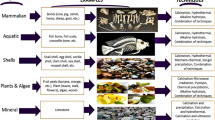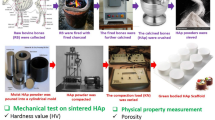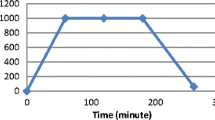Abstract
Excellent biocompatibility and its similar biological characteristics to bone apatite, extensively expand the hydroxyapatite (HA) usage in bioimplant applications. The crystallite size of HA is one of the most administrated parameter for determination of reaction rate at the interface of artificial/natural bones. This study tried to propose a new predictive model by employment of the gene expression programming (GEP), i.e., a powerful soft computing technique, to estimate the crystallite size of HA that were prepared by sol–gel route. Firstly, 37 different reliable experiments were carried out considering the type of phosphor precursor, pH, drying temperature, aging time, temperature and time of calcination as practical parameters as input variables, and HA crystallite size as output variable. Absolute fraction of variance (R2), mean absolute percentage error (MAPE), root relative squared error (RRSE), and mean squared error (MSE) were considered to validate the most appropriate GEP model/s. The experiment results were divided randomly into 29 training sets and 8 testing sets. Finally, the best model was selected in R2 = 0.9929, MAPE = 2.8, RRSE = 0.0956, and MSE = 1.7. The results of simulation confirmed the unique features of GEP for the determination of HA crystallite size prepared by sol–gel route.

Predicted vs. experimental HA crystallite size through GEP-3, GEP-8 and GEP-6 models in (a) training phase, and (b) testing phase.












Similar content being viewed by others
References
Yamashita Y, Uchida A, Yamakawa T, Shinto Y, Araki N, Kato K (1998) Treatment of chronic osteomyelitis using calcium hydroxyapatite ceramic implants impregnated with antibiotic. Int Orthop 22(4):247–251
Ko CL, Chen WC, Chen JC, Wang YH, Shih CJ, Tyan YC, Hung CC, Wang JC (2013) Properties of osteoconductive biomaterials: Calcium phosphate cement with different ratios of platelet-rich plasma as identifiers. Mater Sci Eng C 33(6):3537–3544
Dorozhkin S (2009) Calcium orthophosphates in nature, biology and medicine. Materials 2(2):399–498
Cheng K, Weng W, Han G, Du P, Shen G, Yang J, Ferreira JMF (2003) The effect of triethanolamine on the formation of sol–gel derived fluoroapatite/hydroxyapatite solid solution. Mater Chem Phys 78(3):767–771
Weng W, Baptista JL (1997) A new synthesis of hydroxyapatite. J Eur Ceram Soc 17(9):1151–1156
Kawasaki T (1991) Hydroxyapatite as a liquid chromatographic packing. J Chromatogr A 544:147–184
Suchanek W, Yoshimura M (2011) Processing and properties of hydroxyapatite-based biomaterials for use as hard tissue replacement implants. J Mater Res 13(1):94–117
Elliott JC (1994) Structure and chemistry of the apatites and other calcium orthophosphates. Elsevier Science
Liu DM, Troczynski T, Tseng WJ (2001) Water-based sol–gel synthesis of hydroxyapatite: process development. Biomaterials 22(13):1721–1730
Padmanabhan SK, Balakrishnan A, Chu MC, Lee YJ, Kim TN, Cho SJ (2009) Sol–gel synthesis and characterization of hydroxyapatite nanorods. Particuology 7(6):466–470
Agrawal K, Singh G, Puri D, Prakash S (2011) Synthesis and characterization of hydroxyapatite powder by sol-gel method for biomedical application. JMMCE 10(8):727–734
Hwang K, Song J, Kang B, Park Y (2000) Sol–gel derived hydroxyapatite films on alumina substrates. Surf Coat Technol 123(2):252–255
Layrolle P, Ito A, Tateishi T (1998) Sol–gel synthesis of amorphous calcium phosphate and sintering into microporous hydroxyapatite bioceramics. J Am Ceram Soc 81(6):1421–1428
Montenero A, Gnappi G, Ferrari F, Cesari M, Salvioli E, Mattogno L, Kaciulis S, Fini M (2000) Sol–gel derived hydroxyapatite coatings on titanium substrate. J Mater Sci 35(11):2791–2797
Chai CS, Gross KA, Ben-Nissan B (1998) Critical ageing of hydroxyapatite sol–gel solutions. Biomaterials 19(24):2291–2296
Liu DM, Yang Q, Troczynski T, Tseng WJ (2002) Structural evolution of sol–gel-derived hydroxyapatite. Biomaterials 23(7):1679–1687
Asri RIM, Harun WSW, Hassan MA, Ghani SAC, Buyong Z (2016) A review of hydroxyapatite-based coating techniques: Sol–gel and electrochemical depositions on biocompatible metals. J Mech Behav Biomed Mater 57:95–108
Brinker CJ, Scherer GW (1990) Sol–gel science: the physics and chemistry of sol–gel processing. Academic Press
Cullity BD, Stock SR (2001) Elements of X-ray diffraction (3rd edn). Pearson
Jafari MM, Soroushian S, Khayati GR (2017) Hardness optimization for Al6061-MWCNT nanocomposite prepared by mechanical alloying using artificial neural networks and genetic algorithm. JUFGNSM 50(1):23–32
Mansouri I, Ozbakkaloglu T, Kisi O, Xie T (2016) Predicting behavior of FRP-confined concrete using neuro fuzzy, neural network, multivariate adaptive regression splines and M5 model tree techniques. Mater Struct 49(10):4319–4334
Mansouri I, Kisi O (2015) Prediction of debonding strength for masonry elements retrofitted with FRP composites using neuro fuzzy and neural network approaches. Compos Part B 70:247–255
Jafari MM, Khayati GR (2016) Artificial neural network based prediction hardness of Al2024-Multiwall carbon nanotube composite prepared by mechanical alloying. IJE Trans C 29(12):1726–1733
Mansouri I, Gholampour A, Kisi O, Ozbakkaloglu T (2016) Evaluation of peak and residual conditions of actively confined concrete using neuro-fuzzy and neural computing techniques. Neural Comput Appl. https://doi.org/10.1007/s00521-016-2492-4
Ferreira C (2001) Gene expression programming: a new adaptive algorithm for solving problems. Complex Syst 13(2):87–129
Zhang Q, Zhou C, Xiao W, Nelson PC Improving gene expression programming performance by using differential evolution. In: William C (ed), Sixth international conference on machine learning and applications (ICMLA 2007). https://doi.org/10.1109/ICMLA.2007.62
Ferreira C (2006) Gene expression programming: mathematical modeling by an artificial intelligence (studies in computational intelligence). Springer, New York
Iliadis L, Maglogiannis I, Tsoumakis G, Vlahavas I, Bramer M (2009) Artificial intelligence applications and innovations: proceedings of the 5th IFIP conference on artificial intelligence applications and innovations. Springer, Incorporated
Jafari S, Mahini SS (2017) Lightweight concrete design using gene expression programing. Constr Build Mater 139:93–100
Hoseinian FS, Faradonbeh RS, Abdollahzadeh A, Rezai B, Soltani-Mohammadi S (2017) Semi-autogenous mill power model development using gene expression programming. Powder Technol 308:61–69
Martí P, Shiri J, Duran-Ros M, Arbat G, de Cartagena FR, Puig-Bargués J (2013) Artificial neural networks vs. Gene Expression Programming for estimating outlet dissolved oxygen in micro-irrigation sand filters fed with effluents. Comput Electron Agr 99:176–185
Sarıdemir M (2014) Effect of specimen size and shape on compressive strength of concrete containing fly ash: Application of genetic programming for design. Mater Des 56:297–304
Okhovat A, Mousavi SM (2012) Modeling of arsenic, chromium and cadmium removal by nanofiltration process using genetic programming. Appl Soft Comput 12(2):793–799
Zadshakoyan M, Pourmostaghimi V (2013) Genetic equation for the prediction of tool–chip contact length in orthogonal cutting. Eng Appl Artif Intel 26:1725–1730
Khalaj G, Nazari A, Khoie SMM, Khalaj MJ, Pouraliakbar H (2013) Chromium carbonitride coating produced on DIN 1.2210 steel by thermo-reactive deposition technique: thermodynamics, kinetics and modeling. Surf Coat Technol 225:1–10
Topçu İB, Sarıdemir M (2008) Prediction of compressive strength of concrete containing fly ash using artificial neural networks and fuzzy logic. Comput Mater Sci 41(3):305–311
Sarıdemir M (2010) Genetic programming approach for prediction of compressive strength of concretes containing rice husk ash. Constr Build Mater 24(10):1911–1919
Hunter A, Kennedy L, Henry J, Ferguson I (2000) Application of neural networks and sensitivity analysis to improved prediction of trauma survival. Comput Meth Prog Biomed 62(1):11–19
Eshtiagh-Hosseini H, Housaindokht MR, Chahkandi M (2007) Effects of parameters of sol–gel process on the phase evolution of sol–gel-derived hydroxyapatite. Mater Chem Phys 106(2):310–316
Bigi A, Boanini E, Rubini K (2004) Hydroxyapatite gels and nanocrystals prepared through a sol–gel process. J Solid State Chem 177(9):3092–3098
Kim I-S, Kumta PN (2004) Sol–gel synthesis and characterization of nanostructured hydroxyapatite powder. Mater Sci Eng B 111(2):232–236
Acknowledgements
This work was supported by the Iranian National Science Foundation (INSF).
Author information
Authors and Affiliations
Corresponding author
Ethics declarations
Conflicts of interest
The authors declare that they have no conflict of interest.
Additional information
Highlights
-
Preparation of hydroxyapatite (HA) nanocrystallites by sol–gel method;
-
Using of gene expression programming (GEP) for the calculation of HA crystallite size;
-
Presenting of 3 precision GEP models to predict the crystallite size of HA;
-
Finding and studying the most effective factors on the crystallite size of HA.
Rights and permissions
About this article
Cite this article
Mahdavi Jafari, M., Khayati, G.R. Prediction of hydroxyapatite crystallite size prepared by sol–gel route: gene expression programming approach. J Sol-Gel Sci Technol 86, 112–125 (2018). https://doi.org/10.1007/s10971-018-4601-6
Received:
Accepted:
Published:
Issue Date:
DOI: https://doi.org/10.1007/s10971-018-4601-6




